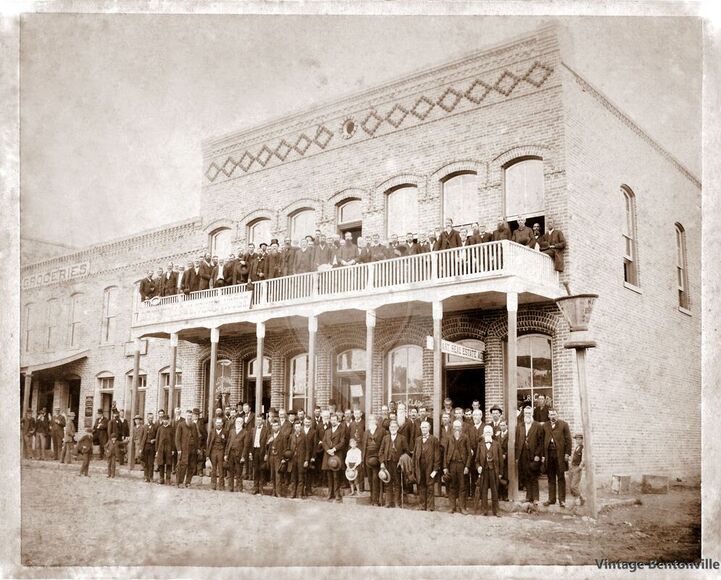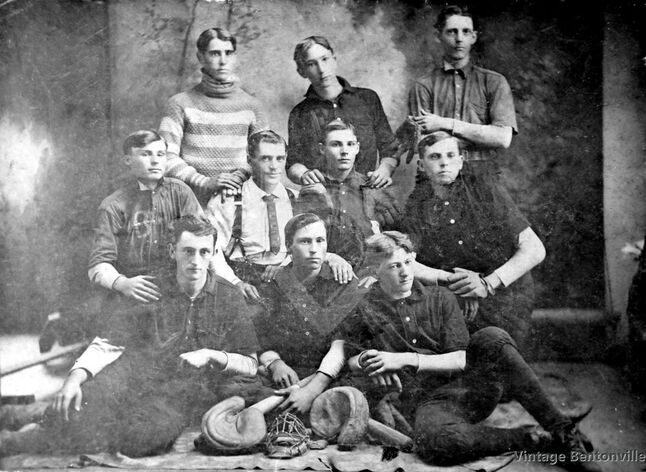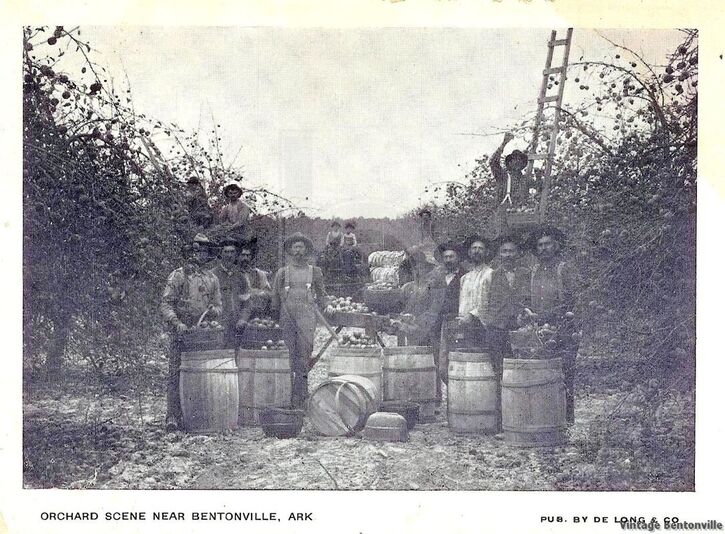Bentonville: Remember The Past To Plan For The Future
Article by Sonya Reynolds recounting stories by Charlie Craig
From the "Benton County at 150" edition, 1986, The Benton County Democrat, now the NWA Democrat Gazette
Article by Sonya Reynolds recounting stories by Charlie Craig
From the "Benton County at 150" edition, 1986, The Benton County Democrat, now the NWA Democrat Gazette
They sauntered around the square, greeting neighbors and admiring fashions. Children played, encouraging their frogs to jump the farthest. And music rang out.
It was the past - and it was the present.
The first week of May - this time for the second year - Bentonville residents turned out on the city streets to celebrate their heritage. During Sugar Creek Days, an annual Bentonville/Bella Vista Chamber of Commerce three-day festival, they mingled the times.
Yet some say the mingling should go much further - that Bentonville should remember the past in planning for the future.
While one longtime resident, Charlie Craig, says that tourism has had a major impact on the city, another says tourism must be expanded.
"We've never really gotten a hold of that and developed it in a manner that would improve the whole area," says Sid McCollum, Bentonville attorney and civic leader. "I'm not advocating Bentonville become something like Branson (Mo., tourist mecca), but there is certainly a lot of opportunity here."
Bentonville didn't go after the industry," says Craig, whose grandfather built the first two-story house in Bentonville. "Due to the influence of the Linebargers - they made us more conscious of tourism and I'm glad... I don't know why there isn't more emphasis on it. "
About 1916, the Linebarger brothers expanded a summer resort at Bella Vista started in 1915 by the Rev. William S. Baker. The resort was later sold to E. L. Keith and finally in 1963 to John A. Cooper Sr.
Craig says what began to change the face of the community was paving of the highways and, in 1929, the square.
But the changes were not dramatic. They just eased in, Craig says.
"I can't remember when (kids) stopped shooting marbles," he says. "They don't do that anymore."
"This really changed with the advent of blacktops," he says.
Bentonville, which was established in 1837, was a city of recreation as well as hard work. Craig, 82, says the most significant thing that happened to Bentonville was the development of Bella Vista. Economically, its impact is followed by Wal-Mart Stores Inc., tourism and the once thriving industry, he says.
When Craig was a boy, the courthouse was where Phillips Food Store parking lot is now [New Town Center as of 2021]. At the site of the current courthouse was an outdoor theater. There was also an opera house where the Bank of Bentonville [later Arvest] is today.
It was the past - and it was the present.
The first week of May - this time for the second year - Bentonville residents turned out on the city streets to celebrate their heritage. During Sugar Creek Days, an annual Bentonville/Bella Vista Chamber of Commerce three-day festival, they mingled the times.
Yet some say the mingling should go much further - that Bentonville should remember the past in planning for the future.
While one longtime resident, Charlie Craig, says that tourism has had a major impact on the city, another says tourism must be expanded.
"We've never really gotten a hold of that and developed it in a manner that would improve the whole area," says Sid McCollum, Bentonville attorney and civic leader. "I'm not advocating Bentonville become something like Branson (Mo., tourist mecca), but there is certainly a lot of opportunity here."
Bentonville didn't go after the industry," says Craig, whose grandfather built the first two-story house in Bentonville. "Due to the influence of the Linebargers - they made us more conscious of tourism and I'm glad... I don't know why there isn't more emphasis on it. "
About 1916, the Linebarger brothers expanded a summer resort at Bella Vista started in 1915 by the Rev. William S. Baker. The resort was later sold to E. L. Keith and finally in 1963 to John A. Cooper Sr.
Craig says what began to change the face of the community was paving of the highways and, in 1929, the square.
But the changes were not dramatic. They just eased in, Craig says.
"I can't remember when (kids) stopped shooting marbles," he says. "They don't do that anymore."
"This really changed with the advent of blacktops," he says.
Bentonville, which was established in 1837, was a city of recreation as well as hard work. Craig, 82, says the most significant thing that happened to Bentonville was the development of Bella Vista. Economically, its impact is followed by Wal-Mart Stores Inc., tourism and the once thriving industry, he says.
When Craig was a boy, the courthouse was where Phillips Food Store parking lot is now [New Town Center as of 2021]. At the site of the current courthouse was an outdoor theater. There was also an opera house where the Bank of Bentonville [later Arvest] is today.
Old Opera House where Arvest sits on the Bentonville Square today
A Chatauqua tent set up often on grounds now inhabited by the old Post Office building. There were traveling speakers and entertainers of all kinds - and there were tent shows.
Entertainment in Bentonville did not stop there. Concerts were held on Saturday nights on the town square. The 142nd Field Artillery Band played frequently after returning from World War I in 1918.
"There was also a theater where Black's Ready-to-Wear is," Craig says. "Silent picture shows. They had a piano, a violin and clarinet play."
And in 1944 there was yet another theater, the Cosey, where Piper's Parlor is today on the square.
But movies, music and plays were not the only activities of the community. Baseball had its moment here, too.
Entertainment in Bentonville did not stop there. Concerts were held on Saturday nights on the town square. The 142nd Field Artillery Band played frequently after returning from World War I in 1918.
"There was also a theater where Black's Ready-to-Wear is," Craig says. "Silent picture shows. They had a piano, a violin and clarinet play."
And in 1944 there was yet another theater, the Cosey, where Piper's Parlor is today on the square.
But movies, music and plays were not the only activities of the community. Baseball had its moment here, too.
Bentonville Baseball Team, 1905. Back Row L to R : Fred Berry, Thurman Bohart, Lloyd Woods, Second Row: Charles Trone, Charles Hopkins, Roland Trone, Morgan McMichastian, Front Row : Frank Hamilton, Frank Trone, Charles Robinson.
In 1948, the Bentonville Blues, a semi-pro team, played at a site later to become Melvin Ford Park. Craig purchased the property which had been used for a horse racing track and turned it into a ballpark. The team played 40 games and won 37.
Some of the players went on to the major leagues, he says.
After one year, Craig disbanded the team and sold the park to the city.
By 1918 the apple business in the area was immense. The roads were not yet paved and the apples were shipped by railroad.
"There were orchards everywhere in those days." Craig says. "There were three grades of apples. No. 1, perfect; No. 2, commercial; and No. 3, culls, those that had two or more bad places on them. The went to the vinegar factory or drying sheds in Rogers."
In 1918, Craig, a sophomore in high school, was taken out of school to screen apples.
"That was when all the men had gone to war." he says. "There was no one to work the orchards except old men, boys and women. The apples had to be graded - screened."
He was out of school for three weeks working 12 hours days for $12 a day. "He paid me every night in $1 bills," Craig says.
Some of the players went on to the major leagues, he says.
After one year, Craig disbanded the team and sold the park to the city.
By 1918 the apple business in the area was immense. The roads were not yet paved and the apples were shipped by railroad.
"There were orchards everywhere in those days." Craig says. "There were three grades of apples. No. 1, perfect; No. 2, commercial; and No. 3, culls, those that had two or more bad places on them. The went to the vinegar factory or drying sheds in Rogers."
In 1918, Craig, a sophomore in high school, was taken out of school to screen apples.
"That was when all the men had gone to war." he says. "There was no one to work the orchards except old men, boys and women. The apples had to be graded - screened."
He was out of school for three weeks working 12 hours days for $12 a day. "He paid me every night in $1 bills," Craig says.
One of the many apple orchards in the Bentonville area



